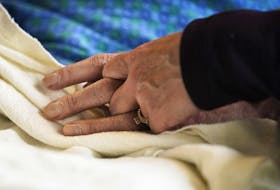When the first COVID-19 wave hit Canada, everyone was understandably anxious and stressed, Dr. Eddy Fan said. But we were lucky. It hit later than other jurisdictions, giving Canadian doctors time to reach out to colleagues around the world and ask, “What’s working? What isn’t?”
Now, as COVID-19 swells in parts of Canada, Fan sees some reassuring signs amid the gloom: “It seems that many of my colleagues around the world who are seeing many more cases than at my own hospital here are suggesting that they’re seeing lower mortality rates,” said Fan, medical director of the Extracorporeal Life Support Program at Toronto’s University Health Network.
Emerging reports suggest fewer people with severe COVID-19 are dying from the disease. One study involving more than 21,000 people admitted to hospitals in England found just 58 per cent of people sent to the ICU in late March with COVID-19 were alive 30 days later. By the end of June, survival had reached 80 per cent. Another study involving more than 5,000 people admitted to one of three New York City hospitals between March and August found the death rate dropped from 26 per cent in March, to eight per cent in August.
People ending up in intensive care in the second wave are, on the whole, younger, and with fewer underlying health problems than those admitted to ICUs in the spring wave. In the New York City study, the median age of those admitted to ICU in March was 63. By August, it was 49. This may explain part of the declining mortality rate, but not all of it. The New York City study was one of the first to adjust for age, co-morbidities (diabetes, obesity, heart disease) and vital signs upon admission, suggesting that the death risk decline in New York City isn’t simply a differing mix of patients, the authors wrote in the Journal of Hospital Medicine.
Instead, the gains are likely due to a combination of factors, including a better understanding of how COVID affects different organ systems and how to manage it, the use of steroids to keep the body’s immune system from overreacting and flipping people onto their stomachs into the “prone” position to improve oxygenation. Another potential life-saving factor, they said, is “lower viral load exposure from increased mask-wearing and social distancing.”
In June, Dr. Donald Griesdale and colleagues reported that the overall death rate for 117 people admitted to one of six ICUs in metro Vancouver between February and April was dramatically lower than mortality rates as high as 62 per cent in the early reports out of Italy.
As of May, 85 per cent of the Vancouver patients were still alive, and 61 per cent had been sent home. The overall mortality rate was 15 per cent.
While they haven’t done a formal analysis on mortality for the second wave, “our experience is consistent” with what others are reporting, Griesdale, a critical care doctor at Vancouver General Hospital and associate professor at the University of British Columbia’s faculty of medicine said in an email to the National Post . “Our mortality is also lower than in the first wave and our thoughts mirror the hypothesis put forth by the other clinicians.”
While the majority of people infected with COVID-19 have mild disease, about eight per cent in Canada are hospitalized, of whom 20 per cent are admitted to the ICU. But even among those admitted to the ICU, there seems to be something different: the lengths of stays are getting shorter, and the survival of those being ventilated is higher.
“It does seem like there definitely is something inherently different now than there was back in the spring,” said Dr. James Downar, a critical and palliative care specialist at The Ottawa Hospital and University of Ottawa. “There may be something about the speed with which people present for care, and the speed with which people are getting resuscitated,” he said.
Doctors are using low-dose steroids, which can cut the risk of death by 12 per cent — “Anyone who’s very sick should get steroids,” University of Pittsburgh critical care doctor Derek Angus told Nature . And they aren’t rushing to connect people to ventilators. “We’re realizing, and the U.K. data is supporting it, that people can tolerate a certain degree of climbing Mount Everest — getting really hypoxic and not doing poorly,” said Dr. Alison Fox-Robichaud, a critical care specialist at McMaster University and past president of the Canadian Critical Care Society.
“We’re becoming more vigilant for some of the complications of COVID, particularly the blood clotting, which is a huge issue,” she said. Doctors aren’t using therapies that potentially could harm, like the malaria drug hydroxychloroquine.
The improvements could get lost if uncontrolled spread of the virus leads to more people in hospital, more ICU admissions and ultimately more deaths. “I’m very concerned about the modelling and what it means if we don’t change what we’re doing,” Fan said.
Doctors in Edmonton have warned the city’s hospitals are at a “tipping point.” A Winnipeg anaesthesiologist warned on Facebook: “The system is breaking along with the backs of those who are trying desperately to hold it together.” As of Tuesday morning, 1,840 people were reported to be in hospital in Canada with COVID-19; 384 were in intensive care. This week, Canada surpassed 300,000 known infections. The true number is likely 10-fold higher.
Doctors are seeing family clusters — siblings or multiple family members admitted to ICU after a family event where no one was wearing masks. There’s no obvious pattern to explain why an entire family can get sick while other families risking the same exposures don’t.
It does seem like there definitely is something inherently different now than there was back in the spring
It’s also not clear whether there was something fundamentally different about the people who got critically sick in the first wave. Scientists recently reported that more than 10 per cent of people who develop severe COVID-19 might have “autoantibodies” that mistakenly target and attack the immune system and not the virus itself.
Others have said it’s not just a binary issue — dead/not dead. COVID can cause a wide range of lingering problems, including kidney or heart damage. Studies have found a staggeringly high risk of stroke with COVID-19. And those who survive an ICU stay for severe COVID can struggle with physical weakness, anxiety, depression and cognitive and memory problems.
“We’re starting to see a mortality that I don’t think is in excess of what we would normally see for a sick person with an infection ending up in an ICU bed,” Fox-Robichaud said. “But it’s the fact that we’ve got so many more infections out there.”
• Email: [email protected] | Twitter: sharon_kirkey
Copyright Postmedia Network Inc., 2020









